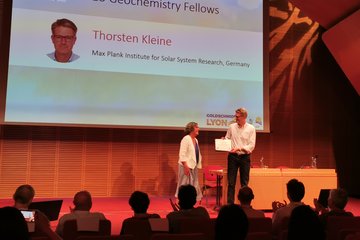Alle Typen
221.
Konferenzbeitrag
Quiet-time 1 MeV/nucleon fluxes as observed by the EPAC instrument on board Ulysses. In: Proc. 24th International Cosmic Ray Conf., S. 439 - 442. ANY PUBLISHER, Rome (1995)
222.
Vortrag
Venus - unsere kaum bekannte Nachbarin. Haus der Astronomie, Heidelberg, Germany (2021)
223.
Vortrag
The Venus Flybys by BepiColombo - Prospects for Ion Observations. 4th BepiColombo virtual SWT (2020)
224.
Vortrag
The magnetic flux transport along the -Esw direction in the magnetotails on Mars and Venus. 22nd EGU General Assembly, online (2020)
225.
Vortrag
The induced magnetosphere of Mars. Fields, forces, currents. AGU Fall Meeting, San Francisco, USA (2019)
226.
Vortrag
Calibration of Electrostatic Analyzers to Study Planetary Magnetospheres and Icy Moons. EPSC-DPS Joint Meeting 2019, Geneva, Switzerland (2019)
227.
Vortrag
Calibration of Electrostatic Analysers to Study Planetary Magnetospheres and Icy Moons. EPSC-DPS Joint Meeting 2019, Geneva, Switzerland (2019)
228.
Vortrag
Energetic ion depletions near the Galilean moons. EPSC-DPS Joint Meeting 2019, Geneva, Switzerland (2019)
229.
Vortrag
Energetic ion depletions near the Galilean moons: atmospheric interaction and indications of the charge state. EPSC-DPS Joint Meeting 2019, Geneva, Switzerland (2019)
230.
Vortrag
The BepiColombo flyby at Venus in 2020: analysis of the scientific outcome. EPSC-DPS Joint Meeting 2019, Geneva, Switzerland (2019)
231.
Vortrag
Ionopause-like gradients in the ionospheric dayside of Venus and Mars in light of radio science observations. EPSC-DPS Joint Meeting 2019, Geneva, Switzerland (2019)
232.
Vortrag
Ionopause-Like Gradients in the Martian Dayside Ionosphere: Comparing Mars Express MaRS and MARSIS Observations. Ninth International Conference on Mars, Pasadena, CA, USA (2019)
233.
Vortrag
The BepiColombo Venus flybys - scientific perspective. Observatory of University of Coimbra, Coimbra, Portugal (2019)
234.
Vortrag
The MSA Instrument (Mass Spectrum Analyzer) Onboard Bepi Colombo MMO (Mercury Magnetospheric Orbiter). Mercury: Current and Future Science of the Innermost Planet, Columbia, Maryland, USA (2018)
235.
Vortrag
Global Flows Of Energetic Ions In Jupiter's Equatorial Plane During The Galileo Era 1995-2003. European Planetary Science Congress 2018, Berlin, Germany (2018)
236.
Vortrag
Variability of the Martian Upper Ionosphere and ion Escape. MEX and MAVEN Observations. 52 ESLAB Symposium: “Comparative Aeronomy and plasma environment of terrestrial planets", Nordwijk, Netherlands (2018)
237.
Vortrag
Upper Ionosphere of Mars: Structure and Main Drivers. Asia Oceania Geosciences Society (AOGS) 15th Annual Meeting , Honolulu, Hawaii (2018)
238.
Vortrag
Signatures of Europa’s atmosphere in Galileo EPD data during the E12 flyby. Magnetospheres of the Outer Planets Conference , Boulder, Colorado, USA (2018)
239.
Vortrag
The induced global looping magnetic field on Mars. Mars Aeronomy Conference, Boulder, Colorado, USA (2017)
240.
Vortrag
Effects of different drivers on ion fluxes at Mars. MARS EXPRESS and MAVEN observations. European Geosciences Union General Assembly, Vienna, Austria (2017)











